Poorly designed transit systems don't market transit very well
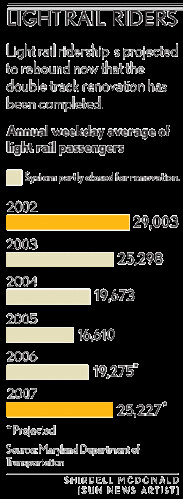
I have been involved in an e-discussion about Baltimore area transit. Unfortunately the conversation is a little skewed in that it features three ardently pro-transit people from Washington who don't know that much about Baltimore, and one person from Baltimore who isn't ardently pro-transit.
But then, it's easy to understand why people in Baltimore aren't necessarily transit advocates when the transit "system" doesn't work very well.
A case in point is the Baltimore Light Rail System, which opened in the late 1980s, but while the DC subway system carries around 700,000 riders daily (on five lines not one), the Light Rail system carries fewer than 25,000 riders/day, on a 20 mile line (the WMATA lines are a bit more than 100 miles of track). By comparison, the Baltimore LR line totals about one and one half of the ridership of DC's highest use bus lines.
The light rail system "reopened" this weekend, after the construction of additional trackage to make the entire system double tracked to reduce delays, and the Baltimore Sun reported on it in "Light rail back on tracks: With reopening of northern stretch, entire line will be double-tracked, but a boost in ridership is not guaranteed." From the article:
Baltimore's Central Light Rail Line is getting its second chance to win the hearts of commuters. The light rail will assume its full role in the region's transportation network tomorrow as the 14-year-old transit system operates for the first time as a two-track line for virtually all its route from Hunt Valley to Anne Arundel County. The Maryland Transit Administration is reopening the rail system's northern stretch, between Timonium and Hunt Valley, after a hiatus of 14 months. It had been closed to complete the final phase of a $154 million project to add a second track along 9.4 miles where there used to be one...
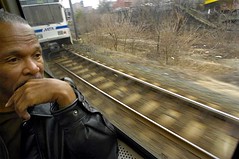 Gilbert Yates of Baltimore, headed north on a light rail train as another passes, depends on the system to get to work.(Sun photo by Amy Davis) Feb 23, 2006
Gilbert Yates of Baltimore, headed north on a light rail train as another passes, depends on the system to get to work.(Sun photo by Amy Davis) Feb 23, 2006Still up in the air is whether double-tracking is the charm that will make Baltimore finally embrace light rail - a system that critics contend was built "on the cheap" - with the same fervor that such cities as Denver and Portland, Ore., have. At station after station along its route, abundant empty parking spaces in free lots tell a story of an underused transit resource.
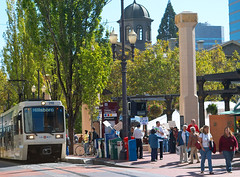 Pioneer Courthouse Square, Portland, Max Light Rail, Protestors, at Lunchtime. Photo by Miles Hochsein, Portland Ground. Portland Light rail vehicles are "low to the ground" and come every 5-8 minutes.
Pioneer Courthouse Square, Portland, Max Light Rail, Protestors, at Lunchtime. Photo by Miles Hochsein, Portland Ground. Portland Light rail vehicles are "low to the ground" and come every 5-8 minutes.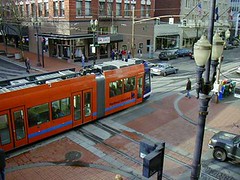 The Portland Streetcar system complements the Light rail system, but only operates within a few mile section of the Downtown and near Downtown area of the city. DC and Arlington County are planning to implement similar systems (with the same Skoda vehicles) to complement WMATA subway and bus transit to build connectivity and convenience, and to promote economic development, at 1/20 of the cost of building underground subways.
The Portland Streetcar system complements the Light rail system, but only operates within a few mile section of the Downtown and near Downtown area of the city. DC and Arlington County are planning to implement similar systems (with the same Skoda vehicles) to complement WMATA subway and bus transit to build connectivity and convenience, and to promote economic development, at 1/20 of the cost of building underground subways."Light rail is not a failure here. It just has not lived up to its expectations," said Walter Sondheim Jr., senior adviser to the Greater Baltimore Committee and the patriarch of the city's redevelopment efforts. State Sen. Lisa A. Gladden is a recent convert to light rail technology after a visit to Portland. But she's no fan of Baltimore's system. The Northwest Baltimore Democrat said the MTA built it with little regard for the communities it passes through.
"It was built to serve suburban communities trying to get to the [Camden Yards] stadium," she said. "If they think double-tracking's going to help, I wish them luck. "But aboard a near-empty light rail train heading south from Timonium last week, lawyer Paul Hazlehurst said the double-tracking project is already paying big dividends in terms of reliability. He said he used to have to wait 20 to 30 minutes for a train. But no more. "It's far better than it used to be," he said. "Now [trains] come about every 10 minutes and it's turned out to be a fairly useful way to commute."...
The return of passenger service to the system's northern reaches marks the completion of a multiyear program to reverse a much-regretted decision during the late 1980s to run a substantial part of a two-way system on one track.
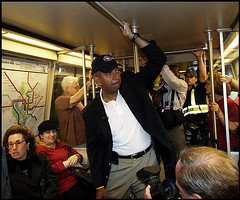 Mayor Williams on the WMATA subway. (Photo from the city website.) Does Governor Ehrlich ride MTA transit very much?
Mayor Williams on the WMATA subway. (Photo from the city website.) Does Governor Ehrlich ride MTA transit very much?That decision, made to hold down costs, was one of many widely acknowledged flaws in the system - including a route that bypassed the most populous corridors, stations without shops or other development, and a stop-and-go crawl though the Howard Street corridor. Together the problems led to disenchantment with light rail. "It's soured Baltimore's appetite for transit because it's slow and it doesn't serve many people," said Nate Payer, spokesman for the Transit Riders Action Council of Metropolitan Baltimore. "I think it was not the best investment we could have made."
_______
Constraining the usefulness of transit systems through decisions that weaken the value and effectiveness of the system dooms the system to failure, and doesn't build a constituency that advocates for transit development and expansion.
Don't think that everyone in the Washington or Portland regions is a staunch advocate for transit, unfortunately many people are committed and devoted to the car still. But you can live in either of these regions quite well without having to own a car, because of where the transit systems can take you--to work, school, home, shopping, to play, etc.
Transit systems to nowhere cost a lot of money and don't accomplish very much. And they certainly make it harder for advocates trying to make arguments in favor of transit.
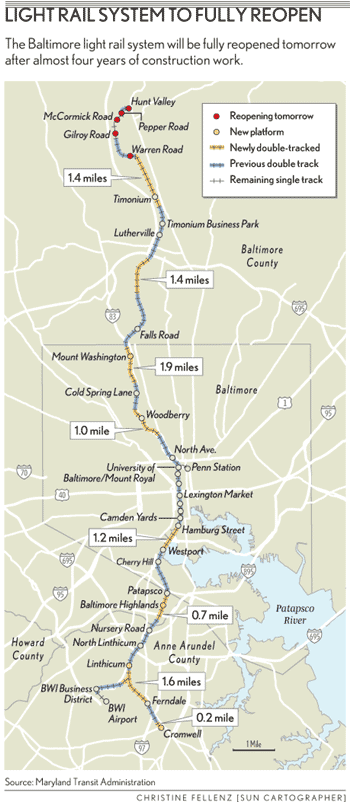
Index Keywords: transit



0 Comments:
Post a Comment
<< Home